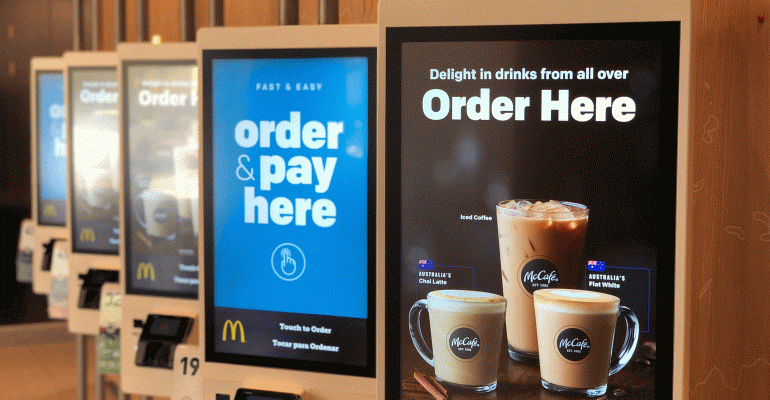McDonald’s first started testing self-service kiosks in 2003 – an ice age ago in tech terms. But it took quite some time for the technology to prove its return. In fact, the McDonald’s U.S. system didn’t implement kiosks systemwide until 2020.
Taco Bell also pressed the gas on kiosks in 2020 and even introduced a kiosk-only Cantina model last year. The technology is expected to play a big role as the chain works toward its 50% digital sales mix goal. Panera was a few years ahead on kiosk integration, and has since made them a focal point of its new digital-only formats.
With heavyweights like McDonald’s, Taco Bell and Panera proving the value of self-order kiosks, the slow trickle that began in 2003 seems to be accelerating into a steady stream at larger chains. This is evidenced from the past few rounds of earnings calls, including Shake Shack’s Q3 call Thursday, in which CFO Katie Fogerty said kiosks are the chain’s most profitable channel, yielding higher check sizes, higher margins and better labor utilization.
That labor utilization piece is particularly critical now, as the industry remains about 500,000 employees short of pre-pandemic numbers. Shake Shack discussed its labor challenges at length during the Q3 call.
“(Kiosks) are another way we’re leaning in … to address some of the labor challenges that we’ve had,” Fogerty said. “Kiosks are a really great lever for us to lean on to help streamline labor and it’s really addressing that front-of-house opportunity. In the Shacks where we have kiosks, a good portion of the guests do prefer the channel. It’s a great opportunity for guests to sit with the menu … and that translates through their order when they’re adding more premium things. So, from both a labor perspective and a check perspective, it’s definitely accretive.”
Kiosks, she adds, allow restaurants to run leaner on labor and also reposition existing labor for other tasks, such as expending orders or greeting guests. The chain plans to outfit nearly every restaurant with a kiosk by the end of next year.
Shake Shack isn’t the only company catching on. Last year, Steak ‘n Shake announced it was replacing table service with self-service kiosks, for instance. BurgerFi began rolling out kiosks during Q2 and CEO Ian Baines noted they have provided “a great guest experience, coupled with the opportunity to upsell guests and provide greater order accuracy.” The kiosks have also yielded an uptick in average check size.
During Yum Brands’ Q3 earnings call Nov. 2, CFO Chris Turner said KFC’s systemwide kiosks sales experienced a 40-plus percent increase in sales year-over-year and now make up 6% of the chain’s sales mix. The potential to continue growing this channel is strong, as just 15% of KFC global restaurants are currently equipped with kiosks.
Indeed, the technology is catching on all over the world and, according to Grandview Research, the global self-service kiosk market is expected to grow at a compound annual rate of 6.5% through 2028. Consider Burger King as another example. The company’s international system experienced over 50% digital sales this year, driven by a strong contribution from kiosks. José Cil, CEO of parent company Restaurant Brands International, recently said the kiosks alleviate some of the labor pressure at the counter.
Domestically, Burger King is even leveraging kiosks as part of its new “Call of Duty: Modern Warfare II” marketing campaign,” in which Acrelec self-service kiosks are used to redesign Burger King restaurants in the style of the video game. According to Acrelec, the company now has over 50,000 kiosks deployed across the world.
While kiosk use for marketing applications is relatively new territory, the value of the self-service technology for labor efficiencies and consumer preferences seems to be growing against a pressured macroeconomic backdrop. That said, the stream of kiosk adoption at major chains contrasts what some smaller operators have realized thus far and underscores the notion that technology is not a one-size-fits-all strategy. Of course, the restaurant industry in general doesn’t adhere to a one-size-fits-all strategy, and concepts that prioritize hospitality and service over speed and convenience aren’t likely to be part of the kiosk conversation anytime soon.




